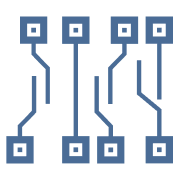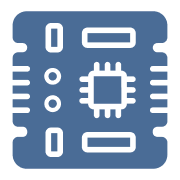Logisim Homework Help - Best Online Help for Students
When it comes to Logisim homework help, TutorBin stands out as the best online platform for students. What sets us apart from others is our dedication to providing tailored support that precisely matches your unique requirements. Our platform holds a team of expert Logisim tutors who are eager to guide you through the complex aspects of this subject, ensuring you grasp its fundamental concepts with ease. We take pride in offering a user-friendly interface that simplifies your learning journey, coupled with prompt assistance that respects your academic deadlines. At TutorBin, our unwavering commitment is to empower you in mastering Logisim, making us your trusted partner in achieving academic excellence.
Logisim Homework Help
Who Can Seek Logisim Help Online?
TutorBin offers comprehensive online Logisim homework help to a diverse range of students and learners. Let's explore the various individuals and groups who can take advantage of our Logisim help:
1. For High School Students
High school students exploring digital circuitry and design principles can greatly enhance their understanding with TutorBin Logisim homework help. We provide accessible resources simplifying Logisim concepts, facilitating a solid grasp of fundamentals. This support not only aids in excelling in coursework but also prepares you for future studies in fields like electrical engineering and computer science. Whether acing high school projects or gearing up for advanced studies, our help with Logisim fosters a strong foundation in both the subject and the software tool.
2. For Undergraduate and Graduate Students
For students pursuing degrees in electrical engineering, computer science, and related fields, TutorBin Logisim homework help offers tailored support. Our comprehensive assistance helps you navigate the complexities of Logisim, ensuring confidence in handling assignments and projects. Whether you're diving into digital circuitry or tackling advanced topics, our Logisim tutors are here to enhance understanding and clarify complex concepts, giving you the solid foundation you need.
Logisim Tutors Online - Is It Worth To Hire Them?
Our team of Logisim tutors consists of experienced subject matter experts deeply versed in logic gates and analog components. Their profound knowledge and unwavering passion for digital electronics drive their commitment to effectively guiding you through the challenges of Logisim. When you choose TutorBin for Logisim help, you gain access to these experts. They possess an exceptional ability to simplify complex circuits, offer valuable insights, and assist you in achieving a high level of proficiency in Logisim.
Whether you're engaged in circuit design, troubleshooting, or tackling specific Logisim assignments, our tutors are dedicated to providing precise guidance. They offer expertise meticulously tailored to your unique learning style. This will ensure significant progress in your Logisim studies, elevate your concept mastery, develop problem-solving skills, and enhance your simulation expertise.
Do My Logisim Homework Help
Challenges Where Students Need Logisim Assignment Help
Logisim assignments present students with a unique set of challenges that can be demanding to overcome. Here, we'll delve into these specific challenges that students face while solving Logisim homework tasks:
1. Complex Digital Circuit Concepts
Logisim assignments delve into complex concepts related to digital circuit design and analysis. These concepts can be overwhelming, particularly for students in the early stages of their digital electronics studies.
2. Unclear Instructions
Some students receive unclear or insufficient instructions for their Logisim assignments from their professors or educational institutions. This lack of clarity can make students uncertain about how to tackle their assignments.
3. Practical Circuit Design
Logisim assignments require students to design digital circuits practically. Students will struggle with circuit layout, simulation, and validation, which can impact the quality of their assignments.
4. Simulation and Testing
Logisim assignments involve simulating digital circuits and testing their functionality. Students may face difficulties in accurately simulating circuits and interpreting simulation results.
5. Optimizing Circuit Efficiency
Creating circuits that are both functional and efficient in terms of component usage can be challenging, requiring students to explore different design techniques.
Logisim Topics & Concepts Covered
| Topics |
Concepts |
| Combinational Logic |
Multiplexers, Demultiplexers |
| Sequential Logic |
Registers, Counters |
| Arithmetic Circuits |
Adders, Subtractors, Multipliers |
| Memory Units |
SRAM, DRAM, ROM, RAM |
| Multiplexers & Decoders |
Priority encoders, Multiplexers |
| Clocking & Timing |
Clock signals, Clock generation |
| Custom Components |
Designing custom logic components |
| Simulation |
Running simulations, testing circuits |
| Wiring and Connections |
Connecting components, wires, buses |
Logisim Assignment Help
What Do You Get When You Pay Someone to Do My Logisim Homework?
Stuck with Logisim assignments and considering, "Can someone do my Logisim homework for me?" Turn to TutorBin Logisim assignment help for the expert assistance you need. We recognize that Logisim can pose its challenges, and we aim to deliver you expert guidance and support for your academic success.
1. Clarity of Concepts
Enhance your Logisim knowledge by gaining clarity on complex concepts and exploring their real-world applications for a comprehensive understanding.
2. Error Detection
With our Logisim assignment help, we conduct thorough error detection and correction, ensuring precise solutions and maintaining the highest quality standards in digital circuit design.
3. Timely Submissions
Ensure on-time assignment submissions with the support of our expert Logisim tutors, who excel at managing deadlines.
4. Affordability
We offer cost-effective Logisim assignment help, making it accessible to students on a budget, without compromising on the quality of assistance.
5. Study Resources
Along with assignment support, you gain access to informative video solutions and a comprehensive library of solved Logisim questions to improve your learning experience.
Imagine facing a daunting Logisim task, like designing a complex digital circuit or troubleshooting a logic error. Our experienced tutors can guide you through these challenges, providing clear explanations and ensuring your assignment is not only completed successfully but also deepening your understanding of the underlying principles.
TutorBin Logisim Homework Help Benefits
At TutorBin, we offer comprehensive Logisim homework help, catering to students worldwide. We aim to simplify the complexities of Logisim and support you in achieving academic excellence in this field. Here's how we can assist you in excelling in Logisim:
1. Expert Guidance
Connect with our expert Logisim tutors, who provide clear explanations, address your queries, and offer tailored expert guidance.
2. Analytical & Problem-Solving Skill Development
Elevate your analytical and problem-solving abilities as we provide hands-on guidance with Logisim assignments and concepts, fostering a robust skillset for tackling complex digital circuit challenges.
3. Error-Free Solutions
We deliver meticulously crafted, error-free solutions, ensuring every step is explained for easy understanding and implementation.
4. Flexible Learning
Recognizing your busy schedule, we offer flexible scheduling options, allowing you to choose the convenient timing that aligns with your availability.
5. Support at All Levels
Whether you're grappling with fundamental Logisim concepts or tackling advanced topics, our tutors can assist you at any level of complexity.
6. Original Work
Our solutions are original and free from copied content, upholding academic integrity and ensuring uniqueness.
7. 24/7 Availability
Learning doesn't adhere to a fixed schedule, and neither do we. TutorBin offers round-the-clock support, ensuring you can access assistance whenever required, even for urgent assignments or last-minute submissions.
8. Free Revisions
We provide free revisions to ensure the solutions meet your expectations and requirements.
9. 100% Secured account
Your privacy is our utmost concern. We guarantee the Secured account of your personal information and the work we do for you.
Logisim Assignment Help - Expert Tutors To Help You Succeed
Are you finding Logisim assignments challenging and overwhelming? Access the best Logisim expert tutors at TutorBin who can make all the difference in conquering your Logisim assignments. Whether you're Struggling with complex concepts or need help in designing circuits, our tutors are ready to break it down for you step by step.
Say goodbye to confusion and frustration when dealing with Logisim. Let our tutors simplify these concepts to boost your confidence so you can complete and submit your Logisim assignments with ease. Our goal is to help you master Logisim effortlessly with the guidance of our experts. No more stress over unfinished assignments – embrace academic excellence with our timely assistance tailored to your needs.
Logisim Homework Help Online - Accessible Worldwide
Our Logisim homework help service is accessible worldwide, offering 24/7 assistance to students regardless of geographical boundaries. Through our online platform, we connect students from around the globe with experienced tutors who are passionate about helping you excel in Logisim. Whether you're studying in Sydney, Australia, or any corner of the world, our user-friendly platform ensures that you can access the best Logisim assignment helpers tailored to your unique learning needs. We aim to equip you with the knowledge and skills necessary to tackle Logisim assignments independently, no matter where you are in the world.
FAQs on Logisim Help Searched By Students
Can I hire someone to do my Logisim homework for me?
Absolutely! At TutorBin, you can pay for our qualified tutors to handle your Logisim homework, leading to a better understanding and improved proficiency in the subject. Seeking assistance from online Logisim tutors can significantly enhance your academic growth.
Can you provide me with instant Logisim assignment help in the USA?
Yes, you can access instant Logisim assignment help in the USA through our 24/7 online platform to promptly address your needs.
What should I do if I need help with Logisim?
If you're looking for help with Logisim, you're in the right place. Just submit your Logisim assignment on TutorBin, and our tutors will provide the guidance you need.
Can experts provide me with a well-researched Logisim assignment solution?
Yes, our experts are equipped to deliver well-researched and tailored Logisim assignment solutions that meet your specific requirements.
Are there online Logisim homework helpers available?
Yes, at TutorBin, you'll find online Logisim homework helpers who can assist you with your assignments and provide valuable support.










